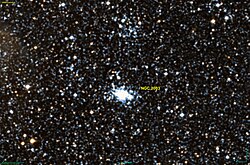Astronomy:NGC 2003
From HandWiki
Short description: Open cluster in the constellation Dorado
| NGC 2003 | |
|---|---|
 Image of NGC 2003 Credit: Donald Pelletier | |
| Observation data (J2000 epoch) | |
| Constellation | Dorado |
| Right ascension | 05h 30m 55.040s[1] |
| Declination | −66° 30′ 05.00″[1] |
| Distance | 163,000 |
| Physical characteristics | |
| Other designations | "PGC 3518064" also known as ESO 086-SC006 and SL 526[2] |
NGC 2003 (also known as PGC 3518064, ESO 086-SC006 and SL 526) is a globular cluster located in the Dorado constellation and is part of the Large Magellanic Cloud.
Background
It is not visible to the naked eye and requires a telescope to observe. The cluster is located at a distance of approximately 163,000 light-years from Earth.[3] It was first discovered by John Herschel on 23 November 1834. Its apparent size is about 1.75 by 0.9 arc minutes.[2]
References
- ↑ 1.0 1.1 "NGC 2003". SIMBAD. Centre de données astronomiques de Strasbourg. http://simbad.u-strasbg.fr/simbad/sim-basic?Ident=NGC+2003.
- ↑ 2.0 2.1 "NGC 2003". cseligman. https://cseligman.com/text/atlas/ngc20.htm#2003.
- ↑ "NGC 2003 - Globular Cluster in Dorado". The Sky Live. https://theskylive.com/sky/deepsky/ngc2003-object.
External links
 |

